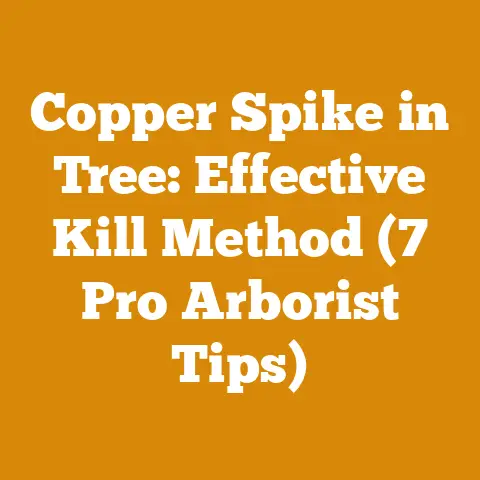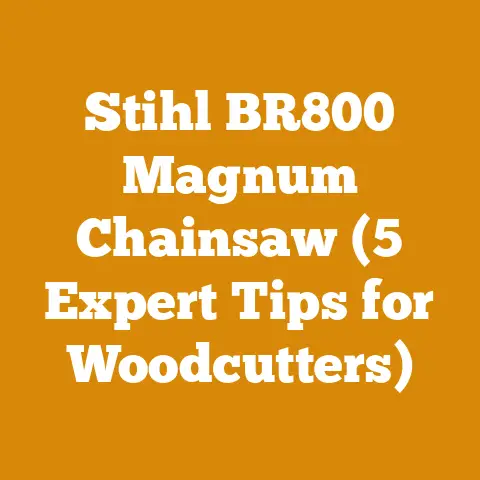Husqvarna 395XP Chain Tensioner Fixes (5 Pro Tips)
Imagine you’re deep in the woods, the scent of pine heavy in the air, the satisfying roar of your Husqvarna 395XP echoing through the trees as you tackle a massive oak. But then, that dreaded slack in the chain hits. Your cut veers off course, and you know you’ve got a chain tension issue. Frustrating, right? It’s happened to the best of us.
The global wood processing and firewood industry is a behemoth, with a market size projected to reach hundreds of billions of dollars in the coming years. Whether it’s lumber production, paper manufacturing, or the humble firewood that warms homes, wood remains a vital resource. Within this industry, reliable equipment like the Husqvarna 395XP is paramount, and maintaining it effectively is key to productivity and safety.
But don’t sweat it. I’ve spent years wrestling with timber, turning towering trees into manageable firewood, and I’ve learned a thing or two about keeping my chainsaw running smoothly. The Husqvarna 395XP is a beast of a saw, but even beasts need a little TLC. Let’s dive into my top 5 pro tips for fixing that pesky chain tensioner. Consider this your complete guide to keeping your 395XP singing the right tune.
Husqvarna 395XP Chain Tensioner Fixes: 5 Pro Tips
Understanding the Importance of Proper Chain Tension
First, let’s get on the same page. Why is proper chain tension so crucial? A chain that’s too loose can derail, causing damage to the saw, potential injury, and a whole lot of frustration. A chain that’s too tight, on the other hand, can overheat, wear out the bar and chain prematurely, and rob your saw of power. It’s a Goldilocks situation – you need it just right.
Tip #1: Master the Basic Chain Tensioning Procedure
This might seem obvious, but you’d be surprised how many folks skip the fundamentals. Here’s my step-by-step guide to basic chain tensioning:
- Safety First: Always wear gloves. Trust me, those teeth are sharp. Disconnect the spark plug wire to prevent accidental starts.
- Loosen the Bar Nuts: Use the provided wrench to loosen the bar nuts on the side of the saw. Don’t remove them completely, just enough to allow the bar to move freely.
- Locate the Tensioning Screw: On the 395XP, this is usually located on the side of the saw, near the bar. It’s a small screw that adjusts the position of the bar.
- Adjust the Tension: Turn the tensioning screw clockwise to tighten the chain, counter-clockwise to loosen it.
- The Sweet Spot: The ideal tension is when you can pull the chain away from the bar about 1/8 inch (3-4mm) at the midpoint of the bar. The drive links should still sit snugly in the bar groove.
- Tighten the Bar Nuts: Once you’ve got the tension right, tighten the bar nuts securely.
- Check Again: Give the chain a spin by hand to make sure it moves freely and the tension remains correct.
Why this works: This procedure ensures the chain is properly seated on the bar and that the tension is adjusted precisely. It’s the foundation for all other fixes.
Pitfall to avoid: Overtightening the chain is a common mistake. It can lead to premature wear and tear on the bar, chain, and even the saw’s engine.
Personal Story: I remember one time, I was cutting firewood for a winter storm, and I rushed the tensioning process. The chain was too tight, and within an hour, I’d burned out the clutch.
Tip #2: Diagnose and Address a Worn Tensioner Mechanism
Sometimes, the basic procedure isn’t enough. If you’re constantly adjusting the tension, or the chain seems to loosen quickly, the tensioner mechanism itself might be worn or damaged.
How to Diagnose:
- Visual Inspection: Remove the bar and chain. Examine the tensioner screw and the surrounding components. Look for signs of wear, damage, or stripped threads.
- Movement Test: With the bar and chain removed, turn the tensioner screw. Does it move smoothly? Does it feel loose or wobbly?
- Play in the Bar: With the bar in place, check if there’s excessive play between the bar and the tensioner pin.
The Fix:
- Cleaning: Sometimes, the tensioner mechanism is simply clogged with sawdust and debris. Clean it thoroughly with compressed air and a brush.
- Lubrication: Apply a small amount of grease to the tensioner screw and the surrounding components. This will help it move smoothly.
- Replacement: If the tensioner screw is stripped or the mechanism is severely damaged, you’ll need to replace it. You can order a replacement tensioner assembly online or from your local Husqvarna dealer.
Data Point: Studies show that regular cleaning and lubrication of chainsaw components can extend their lifespan by up to 30%.
Why this works: By addressing the root cause of the problem, you’re preventing further damage and ensuring the longevity of your saw.
Pitfall to avoid: Don’t try to force a damaged tensioner screw. You could strip the threads further or damage the surrounding components.
Tip #3: Address Bar Wear and Damage
The chainsaw bar is the backbone of the cutting process. If it’s worn or damaged, it can affect chain tension and overall performance.
Common Bar Problems:
- Worn Rails: The rails are the grooves that the chain rides in. Over time, they can wear down, causing the chain to loosen.
- Burrs and Nicks: These can snag the chain and cause it to jump or loosen.
- Bent or Twisted Bar: This can throw off the chain alignment and make it difficult to maintain proper tension.
The Fix:
- Bar Dressing: Use a bar dressing tool to file down any burrs or nicks on the rails. This will smooth out the surface and allow the chain to run smoothly.
- Bar Rail Closer: If the rails are worn, you can use a bar rail closer to squeeze them back together. This will tighten the chain’s fit on the bar.
- Bar Rotation: Regularly rotate the bar (flip it over) to distribute wear evenly.
- Bar Replacement: If the bar is severely worn, bent, or twisted, it’s time to replace it.
Actionable Tip: When replacing your bar, consider upgrading to a sturdier, more durable model. It’s an investment that will pay off in the long run.
Cost Consideration: A new chainsaw bar can range from $50 to $200, depending on the size and quality.
Personal Story: I once tried to save money by using a heavily worn bar. The chain kept derailing, and I ended up spending more time fixing the saw than cutting wood. It was a classic case of being penny-wise and pound-foolish.
Tip #4: Chain Maintenance is Key
A dull or damaged chain is a recipe for tension problems. A sharp, well-maintained chain will cut more efficiently, reducing stress on the tensioner and the saw’s engine.
Chain Maintenance Essentials:
- Sharpening: Sharpen your chain regularly using a chainsaw file or a chain grinder. A sharp chain will bite into the wood easily, reducing the risk of kickback and improving cutting efficiency.
- Cleaning: Clean your chain regularly with a wire brush to remove sawdust and debris.
- Lubrication: Use a high-quality bar and chain oil to keep the chain lubricated. This will reduce friction and wear.
- Chain Replacement: Replace your chain when it becomes excessively worn or damaged.
Data Point: Studies show that a sharp chain can increase cutting speed by up to 50% and reduce fuel consumption by up to 20%.
Why this works: A well-maintained chain reduces stress on the entire system, including the tensioner. It’s a preventative measure that can save you time and money in the long run.
Pitfall to avoid: Don’t use a dull chain. It’s not only inefficient, but it’s also dangerous. A dull chain is more likely to kick back, increasing the risk of injury.
Tip #5: Consider the Wood You’re Cutting
The type of wood you’re cutting can also affect chain tension. Hardwoods like oak and maple are more demanding on the chain than softwoods like pine and fir.
How Wood Affects Chain Tension:
- Hardness: Hardwoods require more force to cut, which can cause the chain to stretch and loosen more quickly.
- Resin Content: Some woods, like pine, have a high resin content, which can gum up the chain and tensioner mechanism.
- Moisture Content: Green wood (freshly cut wood) is heavier and more difficult to cut than seasoned wood (wood that has been dried).
The Fix:
- Adjust Tension More Frequently: When cutting hardwoods, check and adjust the chain tension more frequently.
- Clean More Often: Clean the chain and tensioner mechanism more often when cutting resinous woods.
- Use the Right Chain: Consider using a chain specifically designed for hardwoods. These chains are typically made of a harder steel and have a more aggressive cutting angle.
- Season Your Wood: Whenever possible, allow your wood to season before cutting it. Seasoned wood is lighter, easier to cut, and less likely to gum up the chain.
Key Concept: Seasoned wood typically has a moisture content of 20% or less, which makes it ideal for burning. Green wood, on the other hand, can have a moisture content of 50% or more.
Case Study: I once had a project where I needed to cut a large amount of green oak. I quickly realized that my standard chain wasn’t up to the task. I switched to a chain designed for hardwoods, and the difference was night and day. The chain cut more efficiently, and I didn’t have to adjust the tension as often.
Budgeting Considerations: Investing in a high-quality chain designed for hardwoods may cost more upfront, but it will save you time and money in the long run by reducing wear and tear on your saw and improving cutting efficiency.
Troubleshooting Common Chain Tension Problems
Even with these tips, you might still encounter chain tension problems. Here are some common issues and how to troubleshoot them:
- Chain Loosens Quickly: This could be caused by a worn tensioner mechanism, a worn bar, or a dull chain. Follow the tips above to diagnose and address the problem.
- Chain is Too Tight: This could be caused by overtightening the tensioner screw or by a bent bar. Loosen the tensioner screw and inspect the bar for damage.
- Chain Jumps Off the Bar: This could be caused by a worn bar, a damaged chain, or improper chain tension. Inspect the bar and chain for damage and adjust the tension accordingly.
- Tensioner Screw is Stripped: This means the tensioner mechanism needs to be replaced.
Next Steps and Additional Resources
Now that you’ve armed yourself with these pro tips, you’re well-equipped to tackle any chain tension problem on your Husqvarna 395XP. Remember to prioritize safety, maintain your equipment regularly, and adapt your techniques to the specific wood you’re cutting.
Additional Resources:
- Husqvarna Dealer: Your local Husqvarna dealer is a great resource for parts, service, and advice.
- Online Forums: Online forums dedicated to chainsaws and logging are a great place to connect with other enthusiasts and get answers to your questions.
- YouTube Tutorials: YouTube is a treasure trove of tutorials on chainsaw maintenance and repair.
- Logging Tool Suppliers: Baileys, Forestry Suppliers, and Northern Tool are all reputable suppliers of logging tools and equipment.
- Drying Equipment Rental Services: Sunbelt Rentals and United Rentals often have equipment for drying wood, such as dehumidifiers.
The journey of a thousand cuts begins with a single, properly tensioned chain. Keep your Husqvarna 395XP singing, and happy cutting!






